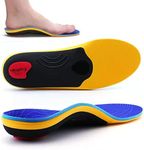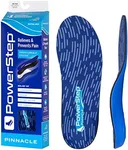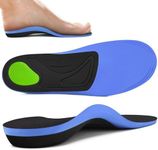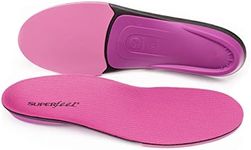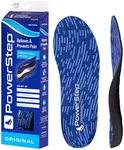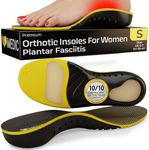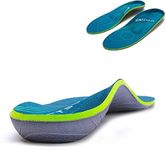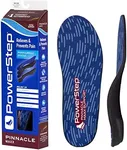Buying Guide for the Best Arch Support Insoles
When choosing arch support insoles, it's important to consider your specific foot needs and the activities you'll be engaging in. Arch support insoles can help alleviate foot pain, improve posture, and enhance comfort during walking or running. The right pair can make a significant difference in your daily comfort and foot health. To find the best fit, you'll need to understand the key specifications and how they relate to your personal requirements.Arch TypeThe arch type of an insole refers to the shape and height of the arch support it provides. This is crucial because it needs to match the natural arch of your foot to provide proper support and comfort. Arch types are generally categorized into low, medium, and high. If you have flat feet, you might need low arch support, while those with a more pronounced arch might require high arch support. It's important to know your foot's arch type, which can be determined by a simple wet test or by consulting a podiatrist, to choose the right insole.
MaterialThe material of the insole affects its comfort, durability, and breathability. Common materials include foam, gel, and cork. Foam insoles are lightweight and provide good cushioning, making them suitable for everyday use. Gel insoles offer excellent shock absorption, ideal for high-impact activities. Cork insoles are durable and provide firm support, often preferred for those needing more stability. Consider your activity level and comfort preference when selecting the material.
CushioningCushioning refers to the insole's ability to absorb impact and provide comfort. This is particularly important if you spend a lot of time on your feet or engage in high-impact activities. Insoles with more cushioning are generally thicker and softer, providing more comfort for prolonged standing or walking. However, if you need more stability or have a specific foot condition, you might opt for less cushioning. Assess your daily activities and comfort needs to determine the right level of cushioning.
Size and FitSize and fit are critical to ensure the insole provides the intended support and comfort. Insoles come in various sizes, often corresponding to shoe sizes, but some may need trimming to fit perfectly. A well-fitting insole should align with your foot's contours and fit snugly in your shoe without causing discomfort. It's advisable to try insoles with the shoes you intend to wear them with to ensure a proper fit. Consider your shoe size and the type of footwear when selecting insoles.
Support LevelSupport level refers to how much structural support the insole provides to your foot. This is important for maintaining proper foot alignment and reducing strain on your feet and legs. Support levels can range from minimal to maximum. If you have specific foot conditions like plantar fasciitis, you might need insoles with higher support levels. For general comfort, moderate support might suffice. Evaluate your foot health and any existing conditions to choose the appropriate support level.
